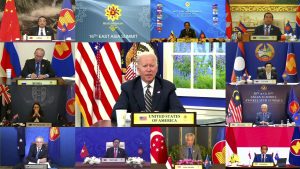Four years of the Trump administration left Asia’s governing elites with a hangover. Many hoped that President Joe Biden would be the cure. On the eve of Biden taking office, pundits widely expected he would restore competence, rhetorical restraint, and a sense of normalcy in Asia policy. Twelve months later, the Biden administration has done precisely that, replacing Trump’s grievance politics and erraticism with a steady decency and respect toward allies and partners.
The problem, however, is that Biden and his staff have also lived up to other expectations: That the United States would promote Asia’s militarization with the vague aim of “countering” China, give the Pentagon a blank check on defense posture and military spending, show ambivalence about international trade, exhibit contradictions in democracy promotion, fail to do anything about a nuclear North Korea, and pursue an internally conflicted China policy that defaulted to competition.
In these respects too, U.S. Asia policy has proven predictable, which is more problematic than reassuring. The totality of the Biden administration’s words and deeds in the region amount to little more than residual inertia from Trump’s military-first approach to Asia plus a modest revival of the Obama era pivot to Asia, which sought to preserve an American hegemony that no longer exists in the region.
The absence of anything that might pass for coherent design or a Biden doctrine is glaring. Put differently, U.S. statecraft in 2021 has become behaviorally consistent, but conceptually schizophrenic. Given the political constraints Biden faces at home and the ideological disposition of his staff, it could hardly be otherwise.
While U.S. policy toward the Indo-Pacific in 2021 showed much greater continuity than change in moving from Trump to Biden, the changes are mostly a boon for near-term stability and perceptions of America as a responsible “Pacific Power.”
Biden has turned down the volume on diplomacy and turned up its frequency. Despite the constraints of the pandemic, for example, the leaders of both Japan and South Korea were granted presidential summits, and the administration has quietly worked out cost-sharing arrangements with both allies – a major source of alliance friction in the Trump era. It has also avoided saber-rattling toward either China or North Korea, in contrast with the Trump administration’s race-baiting jingoism toward the former and gratuitous threats of nuclear annihilation toward the latter.
Stylistic differences aside, the most striking thing about Biden’s Asia policy is how much it resembles Trump’s on all the issues that matter over the long term.

































